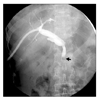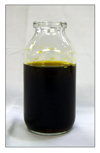Abstract
Cholethorax (bilious pleural effusion) is an extravasation of bile into the thoracic cavity via a pleurobiliary fistula (and also a bronchobiliary fistula). It is an extremely rare complication of thoraco-abdominal injuries. It can be caused by congenital anomaly and also by hepatobiliary trauma, severe infection or iatrogenic procedures. The definitive diagnosis is made with aspiration of bilious fluid from the pleural space during thoracentesis, by finding a fistulous tract during endoscopic retrograde cholangiopancreatography (ERCP) or cholagioscopy, or with finding an abnormal pleural accumulation of radioisotope during hepatobiliary nuclear imaging. Its symptoms include coughing, fever, dyspnea and pleuritc chest pain. Herein we report on a case of cholethorax following performance of percutaneous transhepatic cholangioscopy (PTCS) to remove incidentally discovered common bile duct (CBD) stones.
Figures and Tables
 | Figure 1Follow-up tubography after tract dilatation shows total obstruction of the distal common bile duct (CBD) by a filling defect (arrow), which may be a CBD stone. |
 | Figure 2Chest CT scan shows remnant transhepatic biliary fistula (black arrows) after percutaneous transhepatic cholangioscopy (PTCS) tube removal (A) and right pleural effusion (white arrows) (B). |
 | Figure 3A bottle of fluid shows yellow-brownish bilious fluid from thoracic cavity via chest pigtail catheter. |
 | Figure 4Hepatobiliary scan using 370 MBq of 99mTc-mebrofenin shows the radioactivity in the right pleural space after 30 minutes of injection in anterior view (A) and right lateral view (B) (arrows). After opening the clamp of pigtail catheter which was inserted into the right pleural space, drainage of the accumulated radioactivity is noted (arrowhead). |
References
1. Franklin DC, Mathai J. Biliary pleural fistula: a complication of hepatic trauma. J Trauma. 1980. 20:256–258.
2. Dasmahapatra HK, Pepper JR. Bronchopleurobiliary fistula. A complication of intrahepatic biliary stent migration. Chest. 1988. 94:874–875.
3. Weitzman JJ, Cohen SR, Woods LO Jr, Chadwick DL. Congenital bronchobiliary fistula. J Pediatr. 1968. 73:329–334.
4. Brunaud L, Sebbag H, Bresler L, Tortuyaux JM, Boissel P. Left hepatic duct injury and thoracobiliary fistula after abdominal blunt trauma. Hepatogastroenterology. 2000. 47:1227–1229.
5. Feld R, Wechsler RJ, Bonn J. Biliary-pleural fistulas without biliary obstruction: percutaneous catheter management. AJR Am J Roentgenol. 1997. 169:381–383.
6. Navsaria PH, Adams S, Nicol AJ. Traumatic thoracobiliary fistulae: a case report with a review of the current management options. Injury. 2002. 33:639–643.
7. Amir-Jahed AK, Sadrieh M, Farpour A, Azar H, Namdaran F. Thoracobilia: a surgical complication of hepatic echinococcosis and amebiasis. Ann Thorac Surg. 1972. 14:198–205.
8. Roy DC, Ravindran P, Padmanabhan R. Bronchobiliary fistula secondary to amebic liver abscess. Chest. 1972. 62:523–524.
9. Delco F, Domenighetti G, Kauzlaric D, Donati D, Mombelli G. Spontaneous biliothorax (thoracobilia) following cholecystopleural fistula presenting as an acute respiratory insufficiency. Successful removal of gallstones from the pleural space. Chest. 1994. 106:961–963.
10. Pende V, Marchese M, Mutignani M, Polinari U, Allegri C, Greco R, et al. Endoscopic management of biliopleural fistula and biloma after percutaneous radiofrequency ablation of liver metastasis. Gastrointest Endosc. 2007. 66:616–618.
11. Lehur PA, Guiberteau-Canfrère V, Bury A, Cloarec D, Le Borgne J. "Cholethorax" revealing injury to the common bile duct after celioscopic cholecystectomy. Ann Chir. 1992. 46:450–452.
12. Pisani RJ, Zeller FA. Bilious pleural effusion following liver biopsy. Chest. 1990. 98:1535–1537.
13. Ichikawa T, Yamada T, Takagi H, Abe T, Ito H, Sakurai S, et al. Transcatheter arterial embolization-induced bilious pleuritis in a patient with hepatocellular carcinoma. J Gastroenterol. 1997. 32:405–409.
14. Armstrong CP, Taylor TV. Intrapleural leakage of bile complicating percutaneous transhepatic drainage of the obstructed biliary tree. J R Coll Surg Edinb. 1982. 27:308–309.
15. Lee MT, Hsi SC, Hu P, Liu KY. Biliopleural fistula: a rare complication of percutaneous transhepatic gallbladder drainage. World J Gastroenterol. 2007. 13:3268–3270.
16. De Meester X, Vanbeckevoort D, Aerts R, Van Steenbergen W. Biliopleural fistula as a late complication of percutaneous transhepatic cholangioscopy. Endoscopy. 2005. 37:183.
17. Boyd DP. Bronchobiliary and bronchopleural fistulas. Ann Thorac Surg. 1977. 24:481–487.
18. Rowe PH. Bilothorax: an unusual problem. J R Soc Med. 1989. 82:687–688.
19. Lee JK. Tc-99m DISIDA hepatobiliary scintigraphy showing bile leakage into the thoracic cavity. Clin Nucl Med. 2001. 26:861–862.
20. Turkington RC, Leggett JJ, Hurwitz J, Eatock MM. Cholethorax following percutaneous transhepatic biliary drainage. Ulster Med J. 2007. 76:112–113.




 PDF
PDF ePub
ePub Citation
Citation Print
Print


 XML Download
XML Download